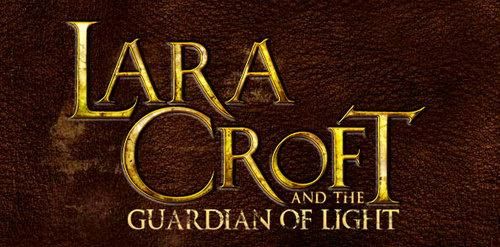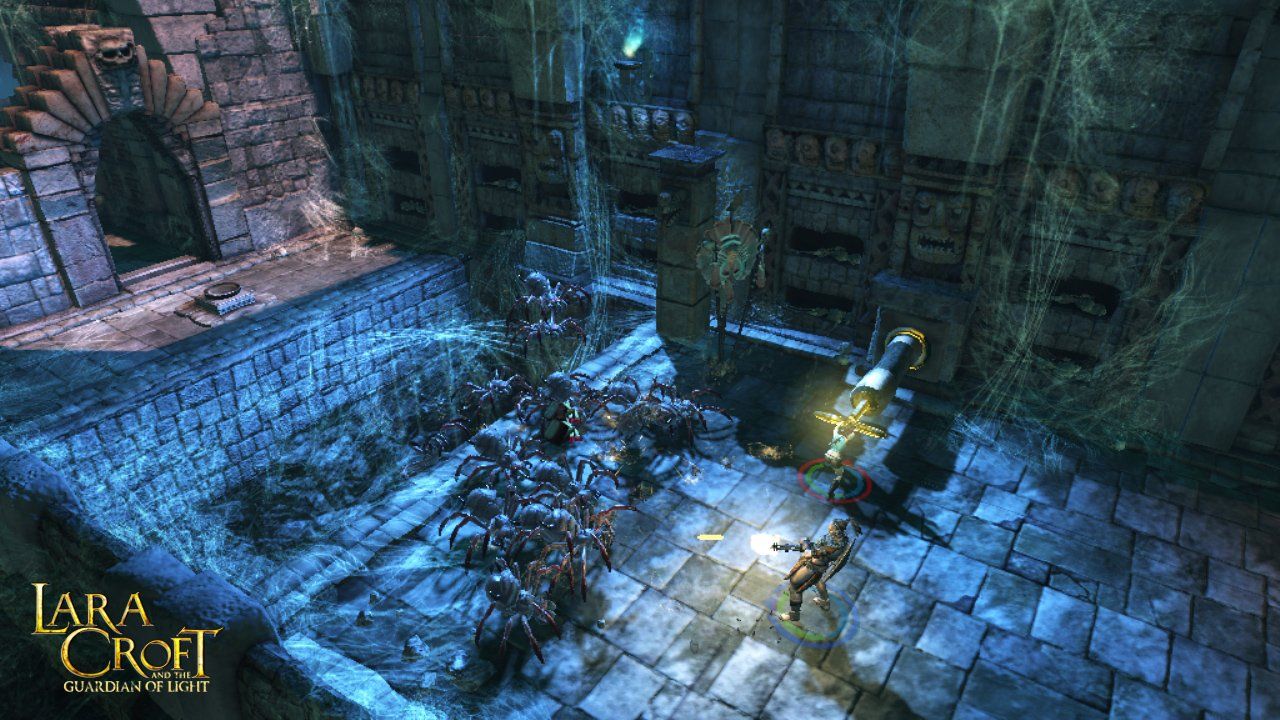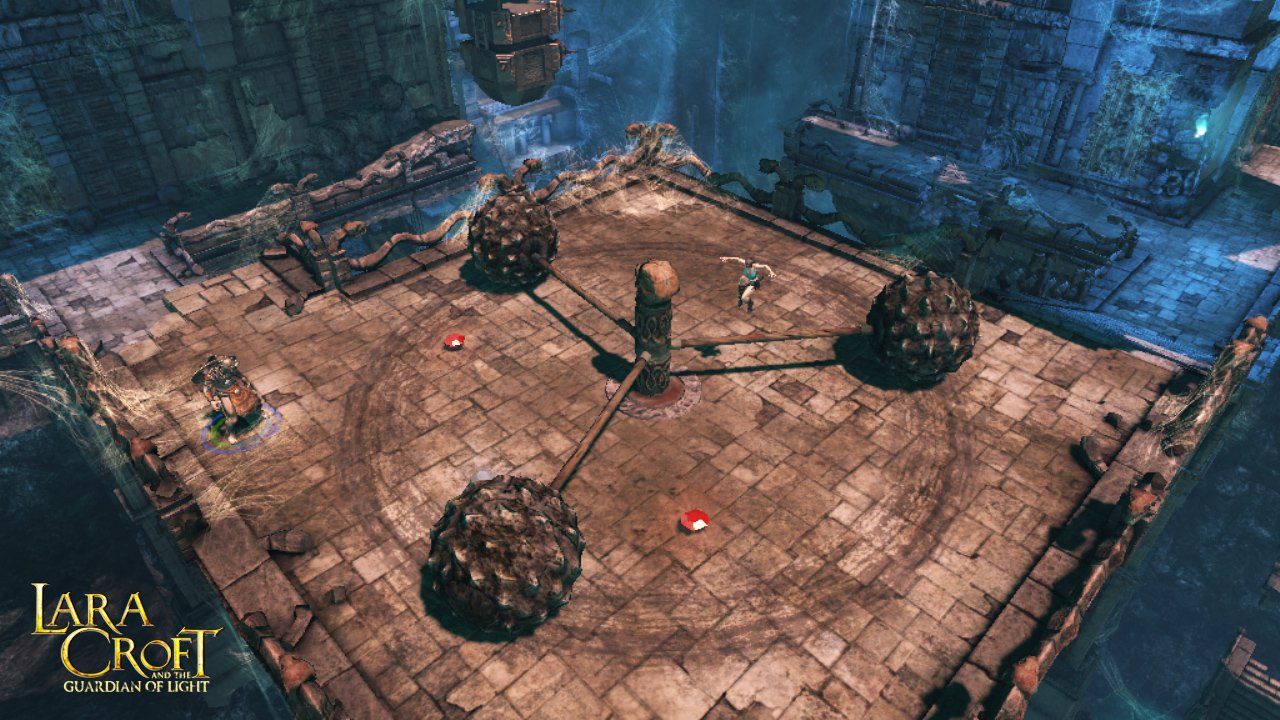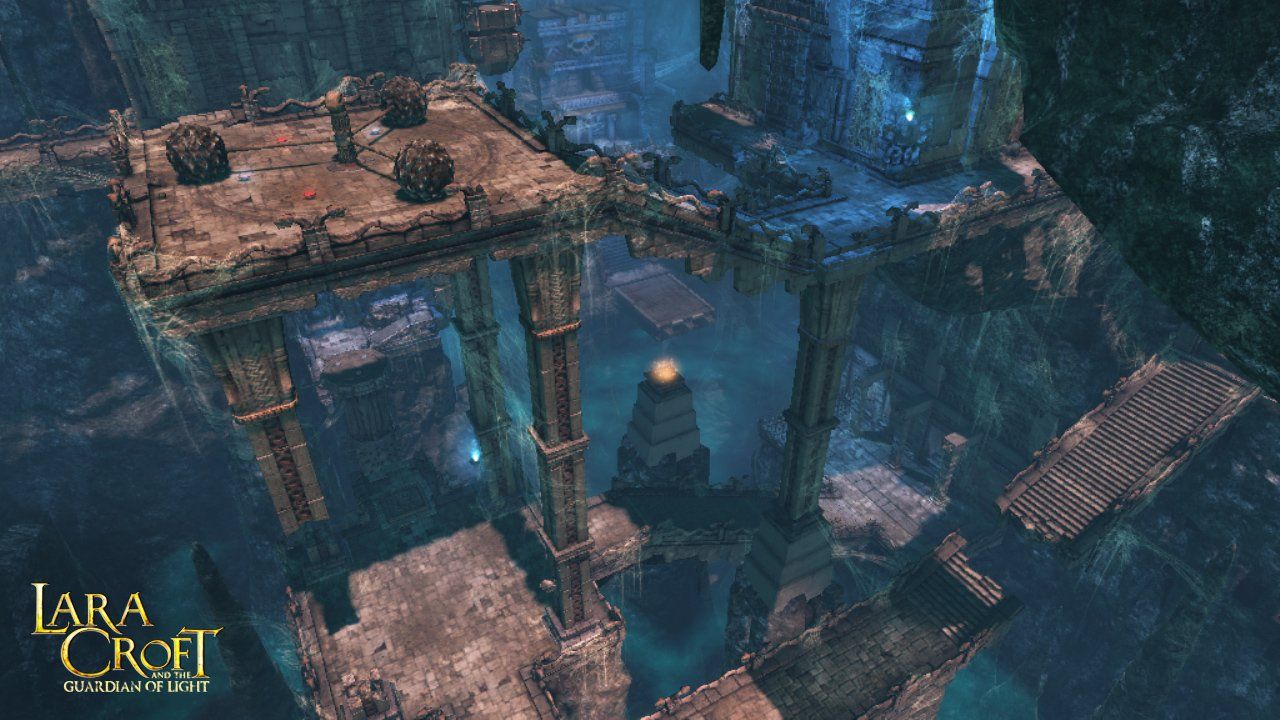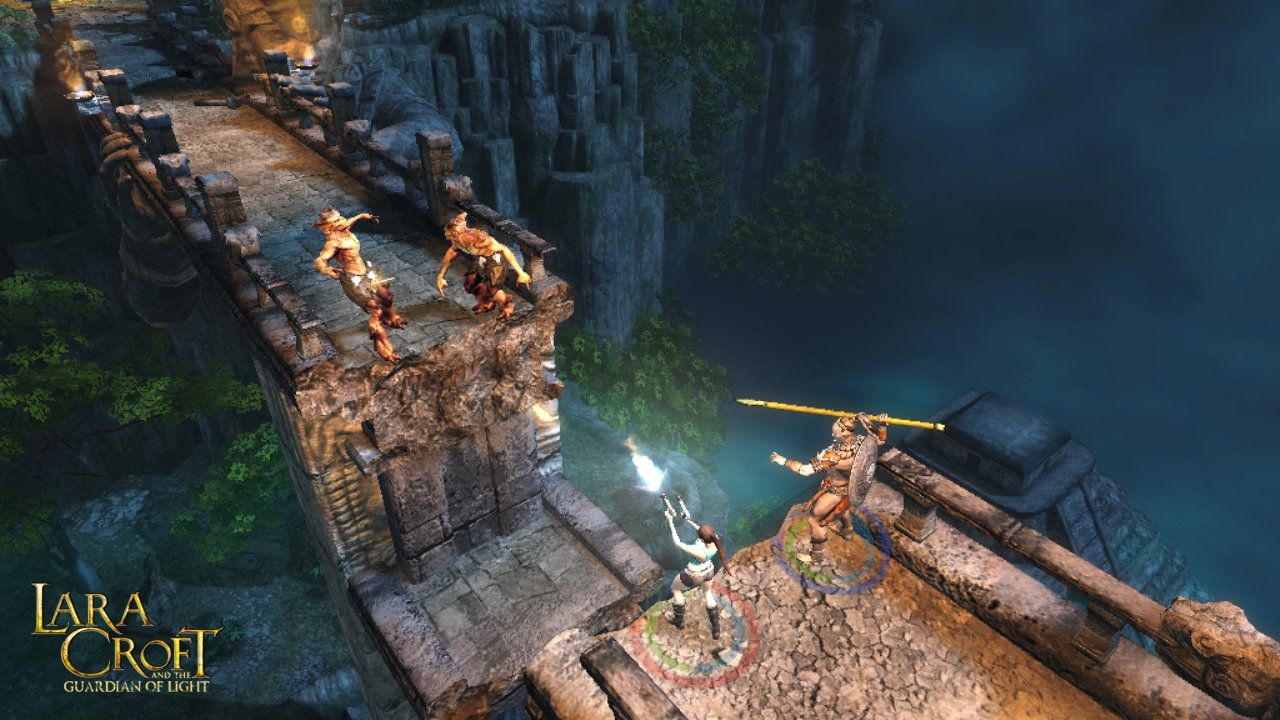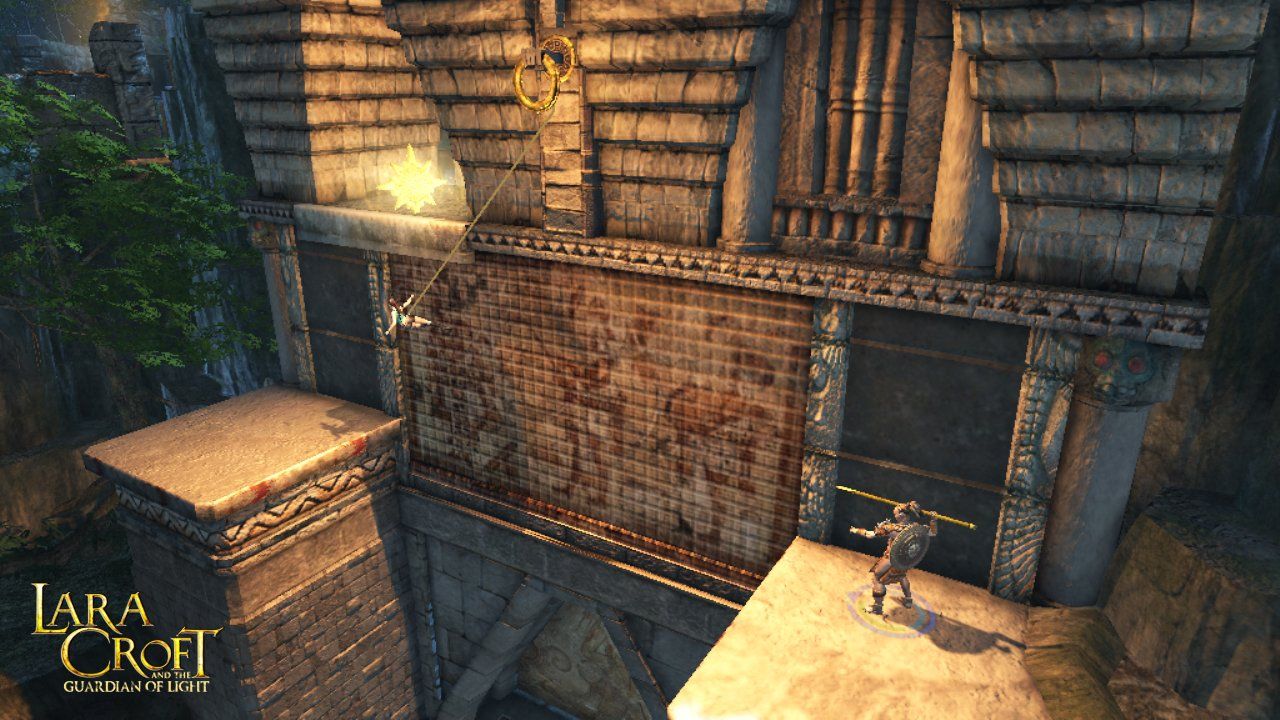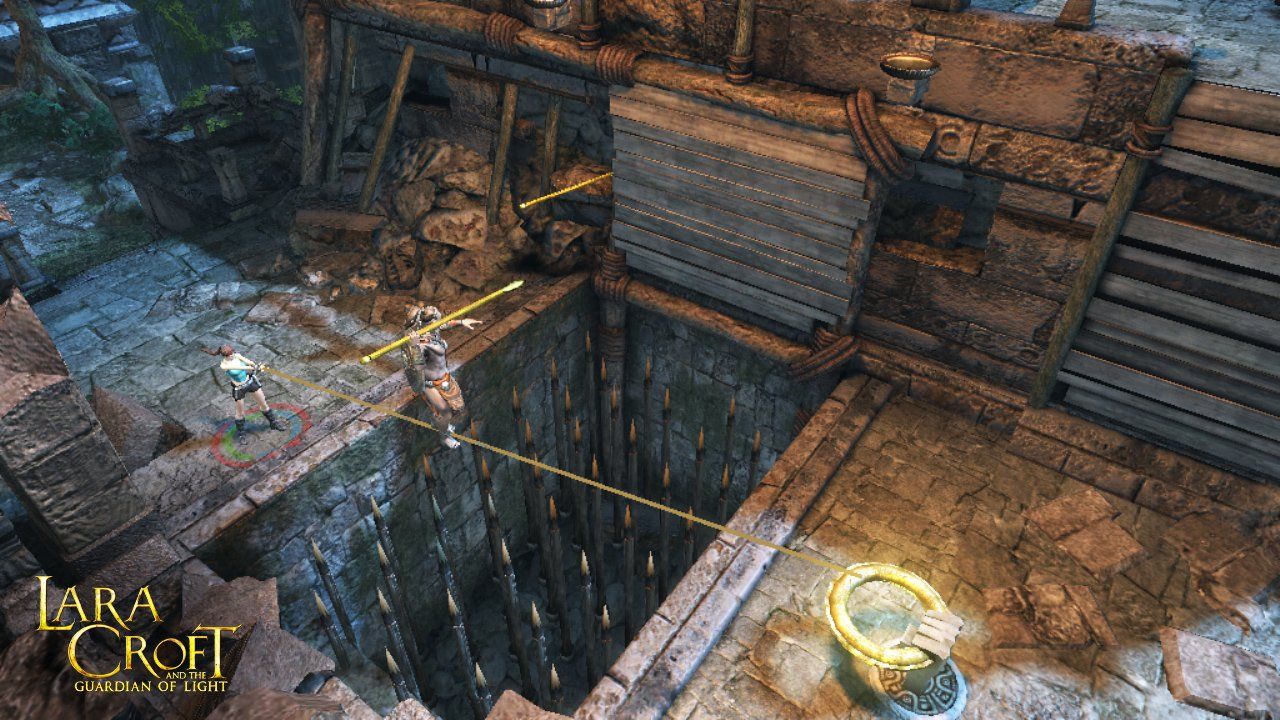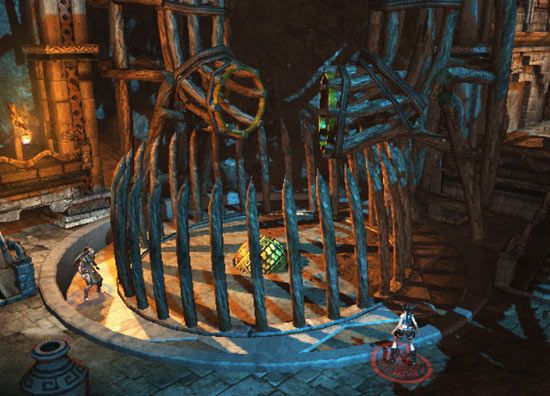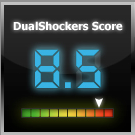When Square Enix ingested Eidos Interactive last year, the future of what was arguably the studios’ biggest franchise became unclear. Needless to say, many fans of the Tomb Raider series considered this change a good one, considering the consistently faltering qualities of the games. In fact, many would argue that the series hasn’t ever been as invigorating as it was during its hay day back in the 90s. It has been said about this next game that changes would be made to give new life to the series.
I have been a fan of Tomb Raider games since the first title. Being well versed in Ms. Croft’s exotic travels, I would have to say that they achieved that goal. In re-branding the series as Lara Croft and leaving behind the Tomb Raider moniker, Square Enix and Crystal Dynamics set out to make a point and from the first moment of game play you will realize this. Lara Croft and The Guardian of Light is a captivating adventure that is excitingly new while providing a faint sense of nostalgia.
The game was clearly crafted with largess of love and care. Having played it quite thoroughly, I would have to say that this is one of Lara’s finer expeditions. Right from the main menu, the game simply oozes a detailed, ambient quality. The game starts with some particularly familiar fare with our heroine of course, raiding a tomb. She tells us about the story of an age old battle in the Aztec land of Yucatan, between The Guardian of Light and a ruler of darkness Xolotl.
A powerful artifact called the Mirror of Smoke is wielded by Xolotl until the Guardian of Light reflects its power and traps Xolotl within it. Of course Lara is interested in this treasure so she searches and eventually discovers it. However, she has lead a group of greedy traders to the treasure as well. So they seize the mirror and release the dark force of Xolotl from it, covering the land with demons and evil once again. The Guardian of Light appears and fails to stop Xolotl from fleeing out into the tainted lands, with his powerful mirror in hand. So, the Guardian of Light, whose name is Totec, decides to join forces with Lara to stop Xolotl once again. While it isn’t very inspired, the story is a good adhesive to the various locales and enemy types you’ll encounter. It all seems very exotic and uncharted (sorry I had to use that adjective, moving on).
Lara is back in all her full figured and quick witted glory. She retains her charmingly daring personality, although it doesn’t get much exercise throughout the game. Her partner Totec though seems quite contrived to me. His manner of speech and even his appearance is very typical for a tribal warrior. It isn’t very inspired at all, though it serves the purpose well enough.
He also never seemed fit to be called The Guardian of Light as he only appeared to help out a few times and only in cut scenes. For the game to be named after him, I didn’t wind up liking him too much. Game play is a pleasant mix of elements combat, exploration, and puzzles that are paced excellently.
As I’m sure you’ve seen by now the camera is practically overhead and very zoomed out from Lara. This is perhaps the largest change from past Tomb Raider games, and personally I think it was worth re-branding the series for. It is a very positive change. You can easily see waves of enemies and both exploration and puzzles benefit from it. It works so well, you’ll consider what the other games would be like if they were done in this manner.
The environments look great and because the game is rather short, they are able to be deeply varied and unique from each other. There is a spider tomb, a poisonous swamp, a lava lake and more exciting maps to explore. The enemy types are equally varying, each possessing a different play style and attack pattern. While they are easy to defeat at first, it’s when they send wave after wave of unique enemies at you that things get tricky. For example, there is a zombie enemy that must first be decapitated and then be blown up, and a shaman that stays far away from the character and shoots projectiles. Combine these with the demons that run up to engage Lara at close range and you’ve got a recipe for excitement.
Combat is handled in a very efficient and fun way. You point the right stick in the direction you want to fire and then use the left trigger to shoot in that direction. It is simpler than it sounds, but the result allows you full range of movement while firing in any direction. Lara can roll to avoid attacks. The roll maneuver is very useful and fast. You will develop the habit of rolling around instead of running, as it is much faster. It also allows you to zoom in on enemies and then back away from them in no time. You can drop bombs that have to be detonated remotely to avoid damaging yourself. Aside from being very useful in combat, they are also needed for a variety of puzzles. There are a huge number of weapons in the game and most are pretty fun and unique. I was reluctant to use weapons that would gradually drain the ammo bar, which is handled almost like MP in an RPG.
You’d be fine with the standard twin pistol set that has infinite fire, but after you try the twin SMGs you’ll be an ammo whore completely. Not that this is a big problem though, because once you’re introduced to guns that require ammo, the game does a superb job of providing you with it. At most you’ll only have to go a few minutes with your standard weapons until you bust open a crate or a jar with some.
The combat is even deeper than the various weapons and enemies though. Throughout the game you will discover relics and artifacts. The artifacts work as accessories, each possessing different attributes. Some increase weapon power, some increase bomb effectiveness, speed, defense, etc. Early on, the only artifacts you run into will also deduct a point from one of the other attributes in exchange for boosting another. As you progress, though, you’ll find better and better artifacts until they have compound abilities. You can equip any two artifacts at one time; even two of the same to stack the bonus. These are fun to collect and customize, allowing you to create a better experience. If you feel like Lara is being hit too hard by the projectile attacks, you can up her defense.
The relics are truly where the life of the combat stems from, though. They are rarer than the artifacts, and instead of attribute bonuses, the relics add abilities and skills. One triples the effective range of bombs, allowing you to haul plenty of ass at one time. Another adds energy buffs to attacks, turning Lara into a demon slaying machine. There is a catch though - the relics only take effect when a relic meter is full. It can be filled by collecting gems from falling enemies and defeating hordes of enemies without taking damage. It adds an edge to the combat that makes you play more stylish and carefully, as the meter can take a while to fill. Another thing that ups the tension is the fact that while the meter is full, it will revert to zero if you take any damage. This only forces you to watch your back though, and keep things challenging. Summarily, it all comes together to make combat very satisfying.
During my play-through on normal, I began to wish for bigger waves of enemies. Once you’re swinging around a machine gun that spits energy bolts, regenerating ammunition and dropping a bomb to roll out of range and take out the room with a button press, you will applaud the game’s combat. Defeating enemies is also your main way to score points. Throughout the levels you collect points that culminate into a score at the end of the level. If this score is high enough, you will be rewarded with special guns, artifacts and relics. It adds yet another incentive to play as efficiently as you can.
Also of note, when you are defeated many points are deducted from this score, so it requires that you be skilled in other aspects of the game, aside from just combat. I nearly forgot but you also get a point bonus for defeating enemies when the relic bar is filled. It may seem like an uneven focus is put on not getting hit, but it really doesn’t become too overwhelming on normal difficulty. You’ll find yourself rolling like a madman to safely avoid projectiles and quick attacks. Perhaps it was because of its simplistic grace that the combat is so commendable, or its vast variety of weapons and skills; either way, it’s very good.
All the levels except for a select few are lush and vivid. The detail in some areas is quite reminiscent of tombs raided in the past, but this is a good thing. The visuals in general are pretty nice. Lighting and textures are all nicely done and they give the game a grandiose feeling you only get in quality DLC games. The production values are certainly high and some set pieces are simply amazing. The enemy models, areas, and effects are all well done. There is very much incentive to fully explore each and every level as well.
Firstly, we have the challenge tombs. These places are often scattered throughout levels and must be found to be explored. Within them, various puzzles must be completed before being rewarded with any number of items. They help spread out the game play and contribute to that good pacing I was talking about earlier. Also, you will find health and ammo boosters throughout the levels to make Lara stronger. These are really important if you want to play through on hard. The next reason you’ll want to fully search the stages are for the red skulls. There are ten of these items in each level, and the rewards for collecting them all are artifacts and relics. Often times, you find artifacts in later levels that you could have already had if you would’ve collected all the skulls. There is also an achievement that requires you to find them all in just one level.
You should also know that you will have to find a good majority of the weapons scattered throughout any given stage. Another pretty good incentive to thoroughly chart the levels is the reward challenges. These challenges often require you to find a certain number of items or complete a certain task for a bonus reward at the end of the level. For example, in one of the earlier stages, you will need to seek out and destroy ten trucks. These are of particular interest because I believe I’ve seen rewards that I missed out on in the challenges and never been able to find them otherwise. You should be netting them all by your second play through though, if you didn’t in your first. You will also be rewarded for finishing levels in a certain time frame. All of these elements give the game an obvious replay quality that truly furthers your enjoyment of it. The levels are all fun so you wouldn’t mind playing through them again if you enjoy the combat and other aspects of the game as much as I did. Not only that but there’s the always lucrative hard mode, should you feel so inclined.
The controls are really tight, with small exceptions to some grappling hook parts. Lara isn’t as acrobatic as she once was since the cartwheels and somersaults have been excluded. She also can’t shoot while in midair, which was one of my favorite things to do in past games starring her. She can still back flip though, but it is strangely difficult to do. The puzzles this time around aim more at thinking than at fanciful feats of agility. There is a large variety of puzzles throughout the game. Even the smallest of them delivers a sense of self satisfaction. While they are generally more forward and easier than in past games, there are some of them that will leave you stumped. It’s only more rewarding when it takes you twenty minutes to figure it out though, and you finally do after much trial and error. It is at these sometimes frustrating moments I am reminded most of trials from games in Lara’s past.
I must note though that there are a few times in the game where you will hit a wall you aren’t able to move past. One point comes to mind when I had to reset the stage after trapping myself between bars. It is easy to see how this could have been accidentally omitted though. Nevertheless, it should be mentioned. One of Lara Croft and The Guardian of Light’s selling points will be its multi-player, and rightfully so. One player takes control of Lara and the other person plays as Totec. After my first hour with two players, I was happy that I decided to go through the single player first. Multi-player actually competes with the single player in terms of enjoyment and delivery. With a second player controlling Totec, the title Lara Croft and the Guardian of Light becomes more appropriate.
You and your friend will have to solve puzzles, explore, and fight monsters together and it really is a lot of fun. You play through all the same stages as in single player, although some significant changes take effect. Totec comes with a useful handful of skills that allow puzzles to be more intricate. For example, he can deflect projectiles with his shield. Aside from providing cover for Lara against hordes of the shaman enemy, he can also intercept arrow traps allowing Lara to safely disable them. He can also throw spears into the wall which Lara can use to cross large gaps. In the single player, she would use these spears but it somehow seems more appropriate for him to be aiding you with them. Once across the gap, Lara can pull Totec over by using her grappling hook.
It is these elements that make the multi-player component seem somehow stronger than its single player counterpart. Once you delve into multi-player, you will find what seems like a more consummate experience that does not to detract from the single player, which is still solid. This is the reason I’m glad to have played single player first; I would probably have had a different opinion of it after traversing the same lands with a partner. Much of the game is remade to accommodate two players, like the puzzles and numbers of enemies, but after you try them both, you’ll see how they were made to go alongside one another. Of particular note, there were a few instances when I was able to clear traps and puzzles in two-player that I was unable to do in single player. This really bothered me since there is no guarantee that people will play multi-player, but perhaps the game simply had me beat on those occasions.
Word is that online co-op will be available once the game launches on the PS3 and PC but honestly, I think the better co-op experience would be the local one. Many times I was happy my cousin and I were sitting right beside one another. We could converse about how to do things better than if we were in different houses and one of us didn’t have a microphone (yikes). Another neat feature is keeping all equipment from the single player mode. I hopped in and ran through all of our enemies because Lara was already pumped up with weapons, relics, HP and ammo from my first play-through. All bonuses you find are split between the players, which erase the need to behave competitively between one another. Furthermore, at the end you have different scores and receive different rewards respectively.
There are also a few cut-scenes you’ll miss out on if you don’t play multi-player. The most notable is towards the beginning where Lara teaches Totec to use a gun when he first gets his secondary weapon. Most of the cut-scenes are rehashed though. Like I said earlier about Totec only showing up to help during cut-scenes in the single player, they are much more appropriate when played with a partner. It is hard to say that the multi-player is summarily better than the single player when you consider that not everybody will be able to enjoy it, but this is the case here.
I have more than just praise for Lara Croft and The Guardian of Light however. The game is short and I mean comically, laughably short. So short in fact, that you could play through both the multi-player and single player in one sitting in less than eight hours if you so choose. This is stabilized by the numerous collectibles and re-playability, but it is certainly no epic, lengthy adventure. In its defense though, the game is paced really well and each area distinguishes itself from the last. If it were more drawn out, its tight and pleasant canon would have probably dissipated. It’s worth referencing the age old saying “Quality over Quantity” in this case. They will be a very entertaining eight hours and let’s face it: if and when you don’t collect everything (which you will need to for the final achievement), you’ll jump right back in and continue to enjoy it. The core game play is strong enough for an exceptionally short game that you’ll just keep coming back to.
In conclusion, Lara Croft and The Guardian of Light is a very nice game. If you enjoyed Tomb Raider games of old, I see no reason why you wouldn’t enjoy this fresh and familiar excursion. The change in camera perspective truly does the game-play a lot of good and this installment just may be the rebirth Lara needs to return to greatness. While its story is a bit of an afterthought and one of its title characters came from the stereotype catalogue, this is without a doubt one of the strongest downloadable titles to hit consoles this year. With shockingly high production values, game-play that is just plain addictive, and two fully entertaining game-play modes, if the game was any better it would have to come on a disc. Although it is wrapped up in a new game, the core components are retained from previous Lara Croft adventures. After seeing first hand this exciting new direction for Lara, I can’t wait until the next game in this “new” series comes out. At the price of $14.99 I find it hard not to recommend this title to both fans of past games and gamers looking for an enjoyable, late summer fling. You will agree that the money was very well spent.
-
Title: Lara Croft and the Guardian of Light
- Platform Reviewed: Xbox 360
- Developer: Crystal Dynamics
- Publisher: Eidos Interactive / Square Enix
- Release Date: August 18, 2010
- MSRP: $14.99
- Review Copy Info: A digital download copy of this game was provided to DualShockers Inc, by the publisher for review purposes.

